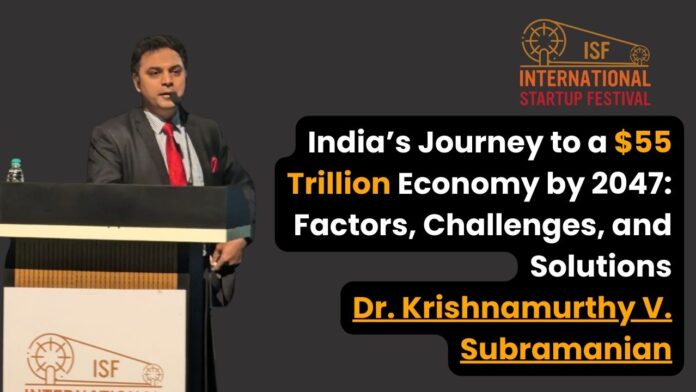India aims to become a $55 trillion economy by 2047, driven by its demographic dividend, technological advancements, robust infrastructure, and global economic integration. However, challenges such as inequality, educational reform, and geopolitical uncertainties must be addressed. Sustainable practices and adaptability are key to achieving this ambitious vision for “Amritkal.
As India approaches its centenary as an independent nation in 2047, a bold vision has been envisaged to transform the country into a $55 trillion economy. This ambitious goal, referred to as “Amritkal,” envisions a prosperous Bharat with an inclusive and sustainable economic framework. The Journey toward this milestone requires a multi-faceted approach, addressing key growth drivers while overcoming significant challenges, said Dr. Krishnamurthy V. Subramanian, Executive Director of the IMF, while speaking at the recently concluded International Startup Festival 2024 in Hyderabad.
According to Dr. Krishnamurthy, the demographic dividend is the first crucial factor driving India’s economic growth. With over 65% of its population under 35, this youthful demographic presents a unique advantage. A skilled workforce can enhance productivity and innovation, propelling various industries forward. To harness this potential “requires a commitment to education and vocational training, enabling our youth to compete globally”, thereby effectively contributing to the economy, said Dr. Subramanian.
Highlighting the technological advancements undertaken by the country, Dr. Krishnamurthy noted that the rapid integration of technology across sectors, from agriculture to services, has acted as a catalyst for economic expansion. Initiatives like Digital India have bridged the digital divide and ensured access to technology for all citizens. “Technology is not just a tool; it is the backbone of our future economy. Embracing innovation will create new industries and jobs, making India a global leader in the digital era.”
According to Dr. Subramanian, by fostering a culture of innovation and entrepreneurship, India could unlock new avenues for growth and position itself as a hub for technological advancements.
Robust infrastructure is crucial for economic expansion. Projects like the National Infrastructure Pipeline aim to invest significantly in roads, railways, airports, and urban development. “Building world-class infrastructure will not only create jobs but also facilitate seamless connectivity, enhancing trade and investment opportunities,” emphasized Dr Krishnamurthy. A well-developed infrastructure will not only support economic activities but also improve the quality of life for citizens.
As the world grapples with climate change, India is positioning itself as “a leader in sustainable development.” The emphasis on renewable energy is a testament to this commitment. The government aims to achieve 500 GW of non-fossil fuel capacity by 2030.
Dr. Subramanian stated, “Our commitment to sustainability will ensure that our economic growth is not at the expense of our planet. We must embrace green technologies for a brighter future.” By investing in sustainable practices and technologies, India can create a resilient economy that thrives without compromising environmental integrity.
Furthermore, strengthening global economic integration is vital for India’s growth. Enhancing trade relations and attracting foreign direct investment (FDI) will be essential. The government’s focus on initiatives like ‘Make in India’ and various trade agreements aims to enhance India’s position in global supply chains. Dr Krishnamurthy states, “We must open our markets and engage with the world. An interconnected economy is essential for our growth story.” By fostering a conducive environment for business and innovation, India can attract foreign investments and elevate its global standing.
Despite the optimistic outlook, New Delhi must address several challenges to realize this vision. One of the primary concerns is “inequality and poverty.” While India has made strides in poverty reduction, significant inequalities persist. The disparity in wealth distribution can hinder overall growth and “create social unrest.”
Calling for inclusive growth, Dr. Subramanian warned that if we leave behind segments of our society, “our journey toward a $55 trillion economy will be compromised.” Bridging the gap between various socio-economic classes will be crucial in fostering social cohesion and ensuring equitable growth.
Another challenge lies in the education sector. Although strides have been made, the quality of education in many areas still needs to be improved. A lack of access to quality education limits the workforce’s potential and hinders innovation. The speaker emphasized the need for reforms in education, stating, “We must focus on not just quantity but also quality. Our educational institutions must nurture critical thinking and creativity.” Addressing this challenge will require significant investments in educational infrastructure and curriculum development.
Moreover, geopolitical uncertainties and global economic shifts could impact India’s growth trajectory. Dr. Krishnamurthy highlighted the importance of adaptability, stating, “We must remain vigilant and adaptable to changes in the global landscape. Our resilience will define our success.” To navigate these uncertainties, India must diversify its economic partnerships and strengthen its position in global supply chains.
In conclusion, the vision of transforming India into a $55 trillion economy by 2047 is “ambitious yet attainable.” Bharat can position itself as a leading global economy by focusing on harnessing its demographic dividend, leveraging technological advancements, investing in infrastructure, promoting sustainable practices, and fostering global integration. However, addressing challenges such as inequality, education, regulatory hurdles, and geopolitical uncertainties will be crucial. As Dr. Krishnamurthy V. Subramanian stated, “Our journey toward a $55 trillion economy will not only redefine our position in the world but also shape the future of our generations to come.” With a unified effort, India can pave the way for a prosperous and inclusive future, celebrating its centenary as a beacon of hope and progress on the global stage.




